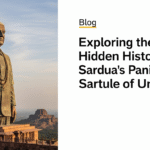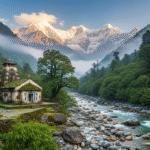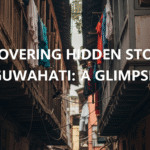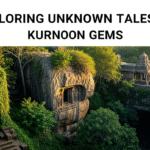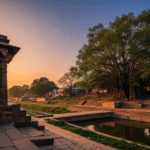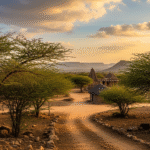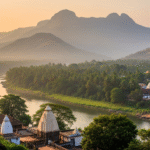Sometimes, great adventures start with wanting to see the world. Walking through Lucknow, you feel connected to its stories. The city, from old lanes of Chowk to new wonders, invites you to its beauty.
Lucknow is where history and culture meet. Every step tells tales of old times, and monuments stand tall. Lose yourself in the Bara Imambara or enjoy Hazratganj Market’s life. The city charms with its timeless beauty and surprises.
Key Takeaways
- Discover the rich heritage of Lucknow, known as the City of Nawabs, through its top tourist spots.
- Visit the magnificent Bara Imambara and delve into its historical significance.
- Experience the cultural brilliance of Chota Imambara and its unique decor.
- Relive history at the British Residency, where architectural beauty meets a storied past.
- Admire the grandeur of the Rumi Darwaza, an architectural masterpiece.
- Enjoy a day at the Lucknow Zoological Garden with family-friendly attractions.
- Pay tribute to social reformers at Ambedkar Park and explore its key features.
Bara Imambara: A Historical Marvel
Bara Imambara is a key historical site in Lucknow. It showcases Awadhi architecture. Built by Nawab Asaf-ud-Daula in 1784, it provided jobs during a famine. It features exquisite design and took 14 years to complete, reflecting Lucknow’s rich culture.
Historical Significance
The Bara Imambara was built to help during a major famine. This large structure gave food and work to many. It now stands as a symbol of Lucknow’s endurance and artistic legacy. Learn more about its history here.
Architectural Features
The Bara Imambara is famous for its Awadhi architecture. Its central hall is among Asia’s largest. The hall is 50 meters long, 16 meters wide, and 15 meters tall. The site includes the Asafi Mosque and the Bhul Bhulaiya maze.
It also has Shahi Baoli stepwell, connecting to the Gomti River. This five-story well is a marvel of engineering.
Visiting Information & Entry Fees
Bara Imambara is open daily except Fridays from 6 am to 6 pm. Entry is ₹50 for Indians and ₹500 for foreigners. Kids enter for ₹25. Cameras cost extra.
It’s easy to get there, with various transport options available. Parking is at ₹20 an hour, making it accessible.
- Bara Imambara entry fee: ₹50
- Chota Imambara entry fee: ₹50
- British Residency entry fee: Free
- Kaiserbagh Palace Complex entry fee: Free
- Hussainabad Clock Tower entry fee: Not applicable
- Tomb of Saadat Ali Khan entry fee: Not applicable
- Jama Masjid entry fee: Free
| Location | Timings |
|---|---|
| Bara Imambara | 06:00 AM to 05:00 PM |
| Chota Imambara | 06:00 AM to 05:00 PM |
| British Residency | 07:00 AM to 06:00 PM |
| Kaiserbagh Palace Complex | 08:00 AM to 08:00 PM |
| Chattar Manzil | 08:00 AM to 06:00 PM |
| Dilkusha Kothi | 08:00 AM to 06:00 PM |
| Hussainabad Clock Tower | Sunrise to Sunset |
| Jama Masjid | 05:00 AM to 09:00 PM |
Chota Imambara: The Palace of Lights
The Chota Imambara is a key landmark in Lucknow, built in 1838. It was made by Nawab Muhammad Ali Shah, the third Nawab of Awadh. People call it the ‘Palace of Lights’. It shows the area’s rich culture and awesome architecture. The building blends Persian, Mughal, and Awadhi styles. It has magical chandeliers from Belgium, detailed carvings, and work in white marble and limestone.
Historical and Cultural Importance
The Chota Imambara first served as a Shia hall. Later, it became a mausoleum for Nawab Muhammad Ali Shah and his mother. Inside, there are Tazias – models of Shia leaders’ graves used in Muharram processions. This place reflects the Nawabi era’s religion, art, and food traditions.
The Royal Bathhouse shows off advanced water heating and drainage. These point to the excellent skills of that time.
Unique Features & Decor
The Palace shines with its stunning decorations. It’s called the Palace of Lights because of its many crystal lamps, old clocks, and mirrors with gold frames. A golden finial, believed to be pure gold, tops the dome. The main hall, Azakhana, has bright chandeliers and calligraphy.
There’s also a mosque, the Husainabad Clock Tower, and the Satkhanda tower. The tower was meant to have seven floors but has only four.
Best Time to Visit
The Chota Imambara is open every day from 8:00 am to 6:30 pm. It’s best to go between 9:00 and 10:00 in the morning. During Muharram, it glows with lamps, candles, and chandeliers. This makes it even more beautiful. The entry fee is ₹25 for Indians and ₹300 for foreigners. This lets everyone enjoy this top site in Lucknow.
| Feature | Details |
|---|---|
| Construction Year | 1838 |
| Built By | Nawab Muhammad Ali Shah |
| Architectural Styles | Persian, Mughal, Awadhi |
| Entry Fee | ₹25 (Indians), ₹300 (Foreigners) |
| Visiting Hours | 8:00 am – 6:30 pm |
| Notable Features | Bengali Chandeliers, Golden Dome, Tazia |
| Nearest Metro Stations | Durgapuri (3 km), Charbagh (3 km), Alambagh (3 km) |
British Residency: Reliving History
The British Residency Lucknow is a powerful symbol of India’s rich history. It especially reminds us of the Indian Rebellion of 1857. It was built in the late 1700s to be a home for British officials. Now, even as ruins, it is a key historical monument in India.
This site mixes old British design and history beautifully. The main building was once a big three-story place. It had a game room, a library, and offices. But it was ruined in the 1857 Siege. Still, parts like the Baillie Gate and the Banquet Hall show the tough spirit of those times. The hall was even turned into a hospital during the fight.
Some buildings at the Residency survived the rebellion. For example, Ommaney’s house, Anderson’s Post, the Judicial Post, and Sago’s house. The Brigade Mess saw heavy fighting in 1857. It shows the hard times back then. Also, there’s a mosque with Persian design. It adds even more history to the British Residency Lucknow.
There’s a graveyard and a church at the Residency. They remember those who died in the rebellion. In front of the main building, a memorial cross honors Major-General Sir John Inglis and his wife Julia. It shows the deep sacrifices people made in those hard times.
Dr. Fayrer’s house gave shelter to British families then. The Residency Museum has photos, records, and objects. These help us learn more about the Indian Rebellion of 1857 and the time of British rule.
The British Residency opens its doors to everyone except on Mondays from 10:00 am to 5:00 pm. It’s a key place for those who love history. Entry is Rs. 15 for Indians and Rs. 200 for people from other countries. It’s a great chance to see one of India’s major historical monuments.
Rumi Darwaza: Gateway to Splendor
Rumi Darwaza is a key part of Lucknow’s history. Built in 1784, it showcases Awadhi architecture. It connects the Bara Imambara and Chota Imambara. This shows the skill of builders from that time.

Architectural Grandeur
The Rumi Darwaza is also called the Turkish Gate. It combines Hindu and Muslim styles. The top has a canopy with Gothic and Roman touches. It’s made of special brick and lime, showing Awadh’s culture.
Historical Context
The gate was finished in 1786 and was important in the Nawabi era. It’s in Old Lucknow, near the Husainabad Imambara. The Rumi Darwaza was a key spot in the 1857 uprising.
This beautiful gate is open all the time and free to visit. It’s close to Lucknow Junction station and the airport. There’s parking nearby, so it’s easy to go see it.
Lucknow Zoological Garden
The Lucknow Zoological Garden is a top spot in the city for family-friendly activities. It lets visitors see lots of animals in Lucknow. The garden opened on November 29, 1921, to mark a royal visit from the Prince of Wales, Edward VIII. It covers 71.6 acres, making it one of India’s biggest zoos.
This zoo is home to 463 animals, 298 birds, and 72 reptiles. It shows the beauty of life from around the globe. The zoo stands out for having an orangutan, a rare sight in India. It has 152 places for animals to live, plus a butterfly park, a state museum, and a place to learn about nature.
The zoo also has fun things like a toy train, a hammock park, and boats. It’s known for being great for families. Plus, there’s a historical gate from 1936 that welcomes you into the animal world.
The zoo is big on teaching about nature. It has a center for learning and does research to help save animals that are in danger. It’s also easy to visit, with lots of toilets, water spots, a hospital for animals, places to rest, carts to ride in, and food to eat.
You’ll need to pay between INR 27 and INR 100 to get in. There are discounts for students. The zoo is open from 5:00 am to 6:00 pm every day but Monday. It’s a place you must see if you love animals and are in Lucknow.
Ambedkar Park: Tribute to Social Reformers
Ambedkar Park is in Gomti Nagar, Lucknow. It’s a beautiful place that honors social reformers. It covers 107 acres and opened on April 14, 2008. Many people visit it for its history and culture. The park is made of red sandstone and looks stunning. Its design wows everyone who sees it.
Overview of Key Features
Ambedkar Park has some amazing things to see. There’s the Ambedkar Stupa and the Pratibimb Sthal, which has 62 elephant statues. There’s also the Dr. Bhimrao Ambedkar Samajik Parivartan Gallery and a museum. The park is beautiful and peaceful. It’s a great place for learning, especially for young people.
- Ambedkar Stupa: A colossal structure designed in memory of Dr. B.R. Ambedkar.
- Pratibimb Sthal: Features 62 elephant statues representing strength and wisdom.
- Museum: Houses artifacts and exhibits related to social reformers.
- Dr. Bhimrao Ambedkar Samajik Parivartan Gallery: Chronicles the journey of social reformers.
Visitor Information
Ambedkar Park is open every day from 11:00 am to 9:00 pm. It’s closed on public holidays and special days. The entry fee is ₹20 for everyone. You can get there by bus, cab, or auto. It’s about 8 km from the Lucknow railway station and 25 km from the airport.
| Attribute | Details |
|---|---|
| Location | Gomti Nagar, Lucknow |
| Spread Over | 107 acres |
| Opening Hours | 11:00 am – 9:00 pm |
| Entry Fee | ₹20 per person |
| Distance from Railway Station | 8 km |
| Distance from Airport | 25 km |
| Transportation Options | Buses, Cabs, Autos |
| Photography | Allowed |
| Notable Attractions | Ambedkar Stupa, Pratibimb Sthal, Museum |
Conclusion
Lucknow tells a story through its amazing sites. It mixes old culture and new vibes perfectly. Every place to visit lets people really feel the city’s heart.
The great Bara Imambara and the pretty Chota Imambara show Lucknow’s history. The British Residency adds to the story. There’s so much to see and learn here.
You can see stunning buildings like the Rumi Darwaza. You can also relax in beautiful parks. Plus, you can try tasty dishes like Tunday Kababi’s kebabs and Idris’ biryanis.
For a nature escape, the Lucknow Zoological Garden is perfect. It’s home to cool animals like Asiatic lions. It’s a fun place for everyone.
Lucknow is a mix of the past and now. It has museums and galleries for culture fans. There’s something here for everyone.
Whether you’re exploring or just having fun, Lucknow won’t disappoint. It’s a must-see in India, especially from October to March. It’s really special.
FAQ
What are the top tourist places in Lucknow to explore now?
Lucknow has amazing spots like Bara Imambara and Chota Imambara. Rumi Darwaza, the British Residency, and Lucknow Zoological Garden are also top attractions. They showcase the city’s history, culture, and stunning buildings.
What is the historical significance of Bara Imambara?
Bara Imambara was built in 1784 by Nawab Asaf-ud-Daula. It’s known for its big architecture and history. There’s the Asfi Mosque, Bhul Bhulaiya, and Shahi Baoli. These places show Lucknow’s rich history and culture.
Can you explain the architectural features of Bara Imambara?
Bara Imambara shows off Awadhi architecture. It has a huge central hall, big gateways, and fine details. The Bhul Bhulaiya maze and Shahi Baoli make it unique. It’s a key historical spot in Lucknow.
What is the entry fee and visiting hours for Bara Imambara?
To see Bara Imambara, Indians pay ₹25 and foreigners pay ₹500. It’s open from sunrise to sunset. This gives everyone enough time to explore it all.
What are the unique features of Chota Imambara?
Chota Imambara is called the ‘Palace of Lights’ because of its chandeliers and lamps. It has beautiful Islamic writing too. Built in 1838 by Muhammad Ali Shah, it’s important in Lucknow’s culture.
When is the best time to visit Chota Imambara?
The best time to see Chota Imambara is between 9:00 and 10:00 in the morning. This lets you experience its beauty fully without too many people around.
What historical events are associated with the British Residency in Lucknow?
The British Residency is linked to the 1857 Indian Rebellion. It was a safe place for British folks during the fight. It’s a big monument that tells the story of the Sepoy Mutiny.
What are the architectural highlights of Rumi Darwaza?
Rumi Darwaza, made in 1784, is 60 feet tall. It looks like Istanbul’s Sublime Porte. With its grand Awadhi style, it links Bara Imambara and Chota Imambara. It’s a key spot in Lucknow.
What can families expect at Lucknow Zoological Garden?
Families will love seeing hundreds of different animals, birds, and reptiles at the zoo. It’s both fun and educational, making it great for family trips to Lucknow.
What are the key features of Ambedkar Park?
Ambedkar Park has 107 acres with the Ambedkar Stupa and Pratibimb Sthal. It features 62 elephant statues, a museum, and a gallery. Made with red sandstone, it honors Dr. B.R. Ambedkar and other reformers.
What are the visitor information details for Ambedkar Park?
You can visit Ambedkar Park every day from 11:00 am to 6:00 pm. It costs ₹20 per person, making it a great value for everyone.
What are some must-visit places in Lucknow for first-time visitors?
First-timers should see Bara Imambara, Chota Imambara, Rumi Darwaza, and the British Residency. Don’t miss the Lucknow Zoological Garden and Ambedkar Park. These spots show off Lucknow’s history, culture, and nature.

